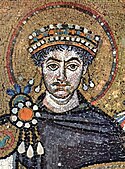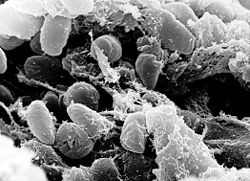Plague -buboes
- Photo Credit:
- Content Providers(s): CDC

|
Dieses Medium stammt aus der Public Health Image Library (PHIL), mit der Identifikationsnummer #2047 der Centers for Disease Control and Prevention. Hinweis: Nicht alle PHIL-Bilder sind gemeinfrei; überprüfe unbedingt den Urheberrechtsstatus und die Nennung der Autoren und Inhaltsanbieter.
|
Relevante Bilder
Relevante Artikel
Justinianische PestBei der Justinianischen Pest, seltener auch Pest des Justinian genannt, handelt es sich um eine zur Zeit des oströmischen Kaisers Justinian (527–565) ausgebrochene Pandemie, die erstmals 541 in Ägypten in den Gesichtskreis der Geschichtsschreiber trat, 542 Konstantinopel erreichte und sich bald darauf im gesamten spätantiken Mittelmeerraum verbreitete. Diese Pandemie trug infolge der Bevölkerungs- und Wirtschaftsverluste möglicherweise indirekt zum Misserfolg der Restauratio imperii Justinians und dem Ende der Antike im 6. Jahrhundert bei. .. weiterlesen





